Spatio-Temporal Vegetation Dynamic and Persistence under Climatic and Anthropogenic Factors
Abstract
1. Introduction
2. Materials and Methods
2.1. Study Area
2.2. Data
2.3. Methods
2.3.1. Linear Regression Model
2.3.2. NDVI-Climate Correlation and Driving Forces Analysis
2.3.3. Future Vegetation Trends: Hurst Exponent
- To divide the time series into sub-series x (t), and for each sub-series t = 1…, τ.
- To define the mean sequence of the time series,
- To calculate the cumulative deviation,
- To create the range of sequence,
- To create the standard deviation sequence,
- To rescale the range,
2.3.4. Validation
3. Results
3.1. Vegetation Dynamic Trend and Driving Forces Analysis
3.2. Trends of Future Vegetation based on H-value and Vegetation Dynamics
4. Discussion
4.1. Validation of R/S Analysis
4.2. Limitations and Future Research Directions
5. Conclusions
- (1)
- Overall arid and the semi-arid regions have been shown to be characterized by improved vegetation conditions from 2000 to 2017 with significant increase in 45.37% and significant decrease in 3.06% area during annual, respectively, while 35.2% increase and 3.3% decrease during growing season, respectively, whereas most of the area has shown no significant trends.
- (2)
- Most of the considerable decline happening in the study area is anomalous during both annual and growing season, and it is in happening in the barren land. Significant increase over most of the study area during both seasons due to multi-control, only during growing season in barren lands, and 51.29% area shows vegetation increase because of climate variability.
- (3)
- There is an overall high consistency in future vegetation trends in arid regions of Sindh province. Stable and steady development region (48.45% during annual and 42.80% during growing season) dominates the future vegetation trends and is followed by positive development.
- (4)
- Croplands and grasslands showed the highest positive development in its total area that is 63.76% and 49.38% during annual and 37.77% and 30.01% during growing season, respectively, whereas the highest negative development can be observed in urban 28.01% and grassland 7.32% during annual, while grasslands 6.5% and urban areas 3.49% during growing season.
- (5)
- Multi-controls have slightly larger impact on future vegetation upward trend than climate variability during annual trends, but the difference is not very large. Significant increase caused by multi-control and climate variability that is likely to continue is found at 94.19% and 93.46% respectively.
- (6)
- Climate variability has a more considerable impact on future vegetation upward trends than multi-controls during growing season. The 95.93% out of total increase under the influence of climate variability is likely to continue, and the 84.11% out of total increase under the influence of multi-controls is likely to continue during growing season.
- (7)
- Climate variability controls future annual decreasing vegetation trends with 90.69% of overall decrease caused by climate variability is likely to continue in the future. Anomalous decrease has more control over future growing season decreasing trends. The 89.87% of overall decrease caused by anthropogenic factors (urbanization and population growth) is likely to continue in the future.
- (8)
- The study area is characterized by an improved vegetation conditions from 2000 to 2017 with significant restoration, and similar trends were estimated for the future.
Author Contributions
Funding
Acknowledgments
Conflicts of Interest
References
- Feng, L.; Jia, Z.; Li, Q. The dynamic monitoring of aeolian desertification land distribution and its response to climate change in northern China. Sci. Rep. 2016, 6, 39563. [Google Scholar] [CrossRef] [PubMed][Green Version]
- Lamqadem, A.; Saber, H.; Pradhan, B. Quantitative Assessment of Desertification in an Arid Oasis Using Remote Sensing Data and Spectral Index Techniques. Remote Sens. 2018, 10, 1862. [Google Scholar] [CrossRef]
- Millennium Ecosystem Assessment Board. Ecosystems and Human Well-Being: Synthesis; Island Press: Washington, DC, USA, 2005. [Google Scholar]
- White, R.P.; Nackoney, J. Drylands, People, and Ecosystem Goods and Services: A Web-Based Geospatial Analysis (PDF Version); World Resources Institute: Washington, DC, USA, 2003; Available online: http://pdf.wri.org/drylands.pdf (accessed on 30 January 2012).
- Vitousek, P.M.; Mooney, H.A.; Lubchenco, J.; Melillo, J.M. Human domination of Earth’s ecosystems. Science 1997, 277, 494–499. [Google Scholar] [CrossRef]
- Reynolds, J.F.; Smith, D.M.S.; Lambin, E.F.; Turner, B.; Mortimore, M.; Batterbury, S.P.; Downing, T.E.; Dowlatabadi, H.; Fernández, R.J.; Herrick, J.E. Global desertification: Building a science for dryland development. Science 2007, 316, 847–851. [Google Scholar] [CrossRef] [PubMed]
- Hountondji, Y.C.; Sokpon, N.; Ozer, P. Analysis of the vegetation trends using low resolution remote sensing data in Burkina Faso (1982–1999) for the monitoring of desertification. Int. J. Remote Sens. 2006, 27, 871–884. [Google Scholar] [CrossRef]
- Wessels, K.J.; Van Den Bergh, F.; Scholes, R. Limits to detectability of land degradation by trend analysis of vegetation index data. Remote Sens. Environ. 2012, 125, 10–22. [Google Scholar] [CrossRef]
- Liu, C.; Melack, J.; Tian, Y.; Huang, H.; Jiang, J.; Fu, X.; Zhang, Z. Detecting Land Degradation in Eastern China Grasslands with Time Series Segmentation and Residual Trend analysis (TSS-RESTREND) and GIMMS NDVI3g Data. Remote Sens. 2019, 11, 1014. [Google Scholar] [CrossRef]
- Kalisa, W.; Igbawua, T.; Henchiri, M.; Ali, S.; Zhang, S.; Bai, Y.; Zhang, J. Assessment of climate impact on vegetation dynamics over East Africa from 1982 to 2015. Sci. Rep. 2019, 9, 16865. [Google Scholar] [CrossRef]
- Chu, H.; Venevsky, S.; Wu, C.; Wang, M. NDVI-based vegetation dynamics and its response to climate changes at Amur-Heilongjiang River Basin from 1982 to 2015. Sci. Total Environ. 2019, 650, 2051–2062. [Google Scholar] [CrossRef]
- Guo, L.; Wu, S.; Zhao, D.; Yin, Y.; Leng, G.; Zhang, Q. NDVI-based vegetation change in Inner Mongolia from 1982 to 2006 and its relationship to climate at the biome scale. Adv. Meteorol. 2014. [Google Scholar] [CrossRef]
- Hou, W.; Gao, J.; Wu, S.; Dai, E. Interannual variations in growing-season NDVI and its correlation with climate variables in the southwestern karst region of China. Remote Sens. 2015, 7, 11105–11124. [Google Scholar] [CrossRef]
- Wu, C.; Venevsky, S.; Sitch, S.; Yang, Y.; Wang, M.; Wang, L.; Gao, Y. Present-day and future contribution of climate and fires to vegetation composition in the boreal forest of China. Ecosphere 2017, 8, e01917. [Google Scholar] [CrossRef]
- Nemani, R.R.; Keeling, C.D.; Hashimoto, H.; Jolly, W.M.; Piper, S.C.; Tucker, C.J.; Myneni, R.B.; Running, S.W. Climate-driven increases in global terrestrial net primary production from 1982 to 1999. Science 2003, 300, 1560–1563. [Google Scholar] [CrossRef] [PubMed]
- Tian, H.; Cao, C.; Chen, W.; Bao, S.; Yang, B.; Myneni, R.B. Response of vegetation activity dynamic to climatic change and ecological restoration programs in Inner Mongolia from 2000 to 2012. Ecol. Eng. 2015, 82, 276–289. [Google Scholar] [CrossRef]
- D’Odorico, P.; Bhattachan, A.; Davis, K.F.; Ravi, S.; Runyan, C.W. Global desertification: Drivers and feedbacks. Adv. Water Resour. 2013, 51, 326–344. [Google Scholar] [CrossRef]
- Stocker, T.F.; Qin, D.; Plattner, G.-K.; Tignor, M.; Allen, S.K.; Boschung, J.; Nauels, A.; Xia, Y.; Bex, V.; Midgley, P.M. Climate Change 2013: The Physical Science Basis; Cambridge University Press: Cambridge, UK, 2013. [Google Scholar]
- Veron, S.; Paruelo, J.; Oesterheld, M. Assessing desertification. J. Arid. Environ. 2006, 66, 751–763. [Google Scholar] [CrossRef]
- Lamqadem, A.A.; Pradhan, B.; Saber, H.; Rahimi, A. Desertification sensitivity analysis using MEDALUS model and GIS: A case study of the Oases of Middle Draa Valley, Morocco. Sensors 2018, 18, 2230. [Google Scholar] [CrossRef]
- Wei, H.; Wang, J.; Cheng, K.; Li, G.; Ochir, A.; Davaasuren, D.; Chonokhuu, S. Desertification Information Extraction Based on Feature Space Combinations on the Mongolian Plateau. Remote Sens. 2018, 10, 1614. [Google Scholar] [CrossRef]
- Tong, X.; Wang, K.; Brandt, M.; Yue, Y.; Liao, C.; Fensholt, R. Assessing future vegetation trends and restoration prospects in the karst regions of southwest China. Remote Sens. 2016, 8, 357. [Google Scholar] [CrossRef]
- Peng, J.; Liu, Z.; Liu, Y.; Wu, J.; Han, Y. Trend analysis of vegetation dynamics in Qinghai–Tibet Plateau using Hurst Exponent. Ecol. Indic. 2012, 14, 28–39. [Google Scholar] [CrossRef]
- Higginbottom, T.P.; Symeonakis, E. Assessing land degradation and desertification using vegetation index data: Current frameworks and future directions. Remote Sens. 2014, 6, 9552–9575. [Google Scholar] [CrossRef]
- Meng, X.; Gao, X.; Li, S.; Lei, J. Spatial and Temporal Characteristics of Vegetation NDVI Changes and the Driving Forces in Mongolia during 1982–2015. Remote Sens. 2020, 12, 603. [Google Scholar] [CrossRef]
- Wang, Y.; Shen, X.; Jiang, M.; Lu, X. Vegetation Change and Its Response to Climate Change between 2000 and 2016 in Marshes of the Songnen Plain, Northeast China. Sustainability 2020, 12, 3569. [Google Scholar] [CrossRef]
- Schmidt, M.; Klein, D.; Conrad, C.; Dech, S.; Paeth, H. On the relationship between vegetation and climate in tropical and northern Africa. Theor. Appl. Clim. 2014, 115, 341–353. [Google Scholar] [CrossRef]
- Jin, H.; Bao, G.; Chen, J.; Chopping, M.; Jin, E.; Mandakh, U.; Jiang, K.; Huang, X.; Bao, Y.; Vandansambuu, B. Modifying the maximal light-use efficiency for enhancing predictions of vegetation net primary productivity on the Mongolian Plateau. Int. J. Remote Sens. 2020, 41, 3740–3760. [Google Scholar] [CrossRef]
- Wu, Z.; Wu, J.; Liu, J.; He, B.; Lei, T.; Wang, Q. Increasing terrestrial vegetation activity of ecological restoration program in the Beijing–Tianjin Sand Source Region of China. Ecol. Eng. 2013, 52, 37–50. [Google Scholar] [CrossRef]
- Khan, A.N.; Ali, A. Desertification Risk Reduction Approaches in Pakistan. In Disaster Risk Reduction Approaches in Pakistan; Springer: Berlin/Heidelberg, Germany, 2015; pp. 161–173. [Google Scholar]
- Irshad, M.; Inoue, M.; Ashraf, M.; Delower, H.K.; Tsunekawa, A. Land desertification-an emerging threat to environment and food security of Pakistan. J. Appl. Sci. 2007, 7, 1199–1205. [Google Scholar]
- Magsi, H.; Atif, S. Water management, impacts and conflicts: Case of indus water distribution in Sindh, Pakistan. Int. J. Rural Stud. 2012, 7, 382–387. [Google Scholar] [CrossRef]
- Adnan, S.; Ullah, K.; Gao, S. Characterization of drought and its assessment over Sindh, Pakistan during 1951–2010. J. Meteorol. Res. 2015, 29, 837–857. [Google Scholar] [CrossRef]
- Mangan, T.; Nangraj, T.; Mitchell, M.; Allan, C.; Punthakey, J. Exploring Options for Improved Groundwater Management Using a Participatory Research Approach in Sindh, Pakistan. In Proceedings of the Australasian Groundwater Conference, Brisbane, Australia, 24–27 November 2019. [Google Scholar]
- Wasim, M.P. Trends and growth in livestock population in Sindh: A comparison of different censuses. Indus J. Manag. Soc. Sci. 2007, 1, 58–75. [Google Scholar]
- Shah, A.H.; Gill, K.H.; Syed, N.I. Sustainable salinity management for combating desertification in Pakistan. Int. J. Water Res. Arid Environ. 2011, 1, 312–317. [Google Scholar]
- Hussain, Z.; Irfan, M. Sustainable land management to combat desertification in Pakistan. J. Arid Land Stud. 2012, 22, 127–129. [Google Scholar]
- Dimitriadis, P.; Koutsoyiannis, D. The mode of the climacogram estimator for a Gaussian Hurst-Kolmogorov process. J. Hydroinform. 2020, 22, 160–169. [Google Scholar] [CrossRef]
- Domonik, A.; Slaby, E.; Smigielski, M. The Hurst exponent as a tool for the description of magma field heterogeneity reflected in the geochemistry of growing crystals. Acta Geol. Pol. 2010, 60, 437–443. [Google Scholar]
- Hosking, J.R. Modeling persistence in hydrological time series using fractional differencing. Water Resour. Res. 1984, 20, 1898–1908. [Google Scholar] [CrossRef]
- Alvarez-Ramirez, J.; Rodriguez, E.; Ibarra-Valdez, C. Medium-term cycles in the dynamics of the Dow Jones Index for the period 1985–2019. Phys. A Stat. Mech. Appl. 2020, 546, 124017. [Google Scholar] [CrossRef]
- López-Lambraño, A.A.; Fuentes, C.; López-Ramos, A.A.; Mata-Ramírez, J.; López-Lambraño, M. Spatial and temporal Hurst exponent variability of rainfall series based on the climatological distribution in a semiarid region in Mexico. Atmósfera 2018, 31, 199–219. [Google Scholar] [CrossRef]
- Kazmi, J.H. Basemap Development and Risk Appraisal; University of Karachi: Karachi, Pakistan, 2013. [Google Scholar]
- Vermote, E.F.; El Saleous, N.Z.; Justice, C.O. Atmospheric correction of MODIS data in the visible to middle infrared: First results. Remote Sens. Environ. 2002, 83, 97–111. [Google Scholar] [CrossRef]
- Hwang, S.-O.; Park, J.; Kim, H.M. Effect of hydrometeor species on very-short-range simulations of precipitation using ERA5. Atmos. Res. 2019, 218, 245–256. [Google Scholar] [CrossRef]
- Iegorova, L.; Gibbs, J.; Mountrakis, G.; Bastille-Rousseau, G.; Paltsyn, M.; Ayatkhan, A.; Baylagasov, L.; Robertus, Y.; Chelyshev, A. Rangeland vegetation dynamics in the Altai Mountain region of Mongolia, Russia, Kazakhstan and China: Effects of climate, topography, and socio-political context for livestock herding practices. Environ. Res. Lett. 2019, 14, 104017. [Google Scholar] [CrossRef]
- Hashimoto, H.; Nemani, R.R.; Bala, G.; Cao, L.; Michaelis, A.R.; Ganguly, S.; Wang, W.; Milesi, C.; Eastman, R.; Lee, T. Constraints to vegetation growth reduced by region-specific changes in seasonal climate. Climate 2019, 7, 27. [Google Scholar] [CrossRef]
- Gao, F.; Anderson, M.C.; Zhang, X.; Yang, Z.; Alfieri, J.G.; Kustas, W.P.; Mueller, R.; Johnson, D.M.; Prueger, J.H. Toward mapping crop progress at field scales through fusion of Landsat and MODIS imagery. Remote Sens. Environ. 2017, 188, 9–25. [Google Scholar] [CrossRef]
- Fensholt, R.; Proud, S.R. Evaluation of earth observation based global long term vegetation trends—Comparing GIMMS and MODIS global NDVI time series. Remote Sens. Environ. 2012, 119, 131–147. [Google Scholar] [CrossRef]
- Stow, D.; Daeschner, S.; Hope, A.; Douglas, D.; Petersen, A.; Myneni, R.; Zhou, L.; Oechel, W. Variability of the seasonally integrated normalized difference vegetation index across the north slope of Alaska in the 1990s. Int. J. Remote Sens. 2003, 24, 1111–1117. [Google Scholar] [CrossRef]
- Wang, B.; Xu, G.; Li, P.; Li, Z.; Zhang, Y.; Cheng, Y.; Jia, L.; Zhang, J. Vegetation dynamics and their relationships with climatic factors in the Qinling Mountains of China. Ecol. Indic. 2020, 108, 105719. [Google Scholar] [CrossRef]
- Rehman, S. Study of Saudi Arabian climatic conditions using Hurst exponent and climatic predictability index. Chaos Solitons Fractals 2009, 39, 499–509. [Google Scholar] [CrossRef]
- Ray, R.; Khondekar, M.H.; Ghosh, K.; Bhattacharjee, A.K. Scaling and nonlinear behaviour of daily mean temperature time series across India. Chaos Solitons Fractals 2016, 84, 9–14. [Google Scholar] [CrossRef]
- Kleinow, T. Testing Continuous Time Models in Financial Markets. Ph.D. Thesis, Humboldt-University, Berlin, Germany, May 2002. [Google Scholar]
- Balkissoon, S.; Fox, N.; Lupo, A. Fractal characteristics of tall tower wind speeds in Missouri. Renew. Energy 2020, 154, 1346–1356. [Google Scholar] [CrossRef]
- Tong, S.; Zhang, J.; Bao, Y.; Lai, Q.; Lian, X.; Li, N.; Bao, Y. Analyzing vegetation dynamic trend on the Mongolian Plateau based on the Hurst exponent and influencing factors from 1982–2013. J. Geogr. Sci. 2018, 28, 595–610. [Google Scholar] [CrossRef]
- Xu, G.; Zhang, J.; Li, P.; Li, Z.; Lu, K.; Wang, X.; Wang, F.; Cheng, Y.; Wang, B. Vegetation restoration projects and their influence on runoff and sediment in China. Ecol. Indic. 2018, 95, 233–241. [Google Scholar] [CrossRef]
- Hurst, H. Long-Term Storage Capacity of Reservoirs. Trans Am. Soc. Civ. Eng. 1951, 116, 770–799. [Google Scholar]
- Planning Commission, Government of Pakistan. Pakistan Millennium Development Goals Report 2013; Ministry of Planning, Development and Reform: Islamabad, Pakistan, 2013. Available online: http://www.undp.org/content/dam/pakistan/docs/MDGs/MDG2013Report/UNDP-Report13.pdf (accessed on 7 April 2020).
- Zhang, Y.; Zhao, S. Desertification: Current State and Trends, Scenarios and Response Options. Adv. Earth Sci. 2008, 3, 12. [Google Scholar]
- Naeem, S.; Zhang, Y.; Tian, J.; Qamer, F.M.; Latif, A.; Paul, P.K. Quantifying the Impacts of Anthropogenic Activities and Climate Variations on Vegetation Productivity Changes in China from 1985 to 2015. Remote Sens. 2020, 12, 1113. [Google Scholar] [CrossRef]
- Zhou, L.; Tucker, C.J.; Kaufmann, R.K.; Slayback, D.; Shabanov, N.V.; Myneni, R.B. Variations in northern vegetation activity inferred from satellite data of vegetation index during 1981 to 1999. J. Geophys. Res. Atmos. 2001, 106, 20069–20083. [Google Scholar] [CrossRef]
- Piao, S.; Mohammat, A.; Fang, J.; Cai, Q.; Feng, J. NDVI-based increase in growth of temperate grasslands and its responses to climate changes in China. Glob. Environ. Chang. 2006, 16, 340–348. [Google Scholar] [CrossRef]
- Chen, C.; Park, T.; Wang, X.; Piao, S.; Xu, B.; Chaturvedi, R.K.; Fuchs, R.; Brovkin, V.; Ciais, P.; Fensholt, R. China and India lead in greening of the world through land-use management. Nat. Sustain. 2019, 2, 122. [Google Scholar] [CrossRef]
- Li, S.-C.; Zhao, Z.-Q.; Gao, Y.; Wang, Y.-L. Determining the predictability and the spatial pattern of urban vegetation using recurrence quantification analysis: A case study of Shenzhen City. J. Geogr. Res. 2008, 27, 1243–1252. (In Chinese) [Google Scholar]
- Fensholt, R.; Rasmussen, K.; Nielsen, T.T.; Mbow, C. Evaluation of earth observation based long term vegetation trends—Intercomparing NDVI time series trend analysis consistency of Sahel from AVHRR GIMMS, Terra MODIS and SPOT VGT data. Remote Sens. Environ. 2009, 113, 1886–1898. [Google Scholar] [CrossRef]
- Huxman, T.E.; Wilcox, B.P.; Breshears, D.D.; Scott, R.L.; Snyder, K.A.; Small, E.E.; Hultine, K.; Pockman, W.T.; Jackson, R.B. Ecohydrological implications of woody plant encroachment. Ecology 2005, 86, 308–319. [Google Scholar] [CrossRef]
- Wilcox, B.P. Transformative ecosystem change and ecohydrology: Ushering in a new era for watershed management. Ecohydrology 2010, 3, 126–130. [Google Scholar] [CrossRef]
- Berry, R.S.; Kulmatiski, A. A savanna response to precipitation intensity. PLoS ONE 2017, 12, e0175402. [Google Scholar] [CrossRef] [PubMed]
- Jacquin, A.; Sheeren, D.; Lacombe, J.-P. Vegetation cover degradation assessment in Madagascar savanna based on trend analysis of MODIS NDVI time series. Int. J. Appl. Earth Obs. Geoinf. 2010, 12, S3–S10. [Google Scholar] [CrossRef]
- Ouedraogo, I.; Runge, J.; Eisenberg, J.; Barron, J.; Sawadogo-Kaboré, S. The re-greening of the Sahel: Natural cyclicity or human-induced change? Land 2014, 3, 1075–1090. [Google Scholar] [CrossRef]
- Sadiq, S. Evaluation of Impact of Climate Change on Pakistan’s Agriculture: Spatial and Temporal Analysis; Pir Mehr Ali Shah Arid Agriculture University: Rawalpindi, Pakistan, 2016. [Google Scholar]
- Li, Y.; Xie, Z.; Qin, Y.; Zheng, Z. Estimating Relations of Vegetation, Climate Change, and Human Activity: A Case Study in the 400 mm Annual Precipitation Fluctuation Zone, China. Remote Sens. 2019, 11, 1159. [Google Scholar] [CrossRef]
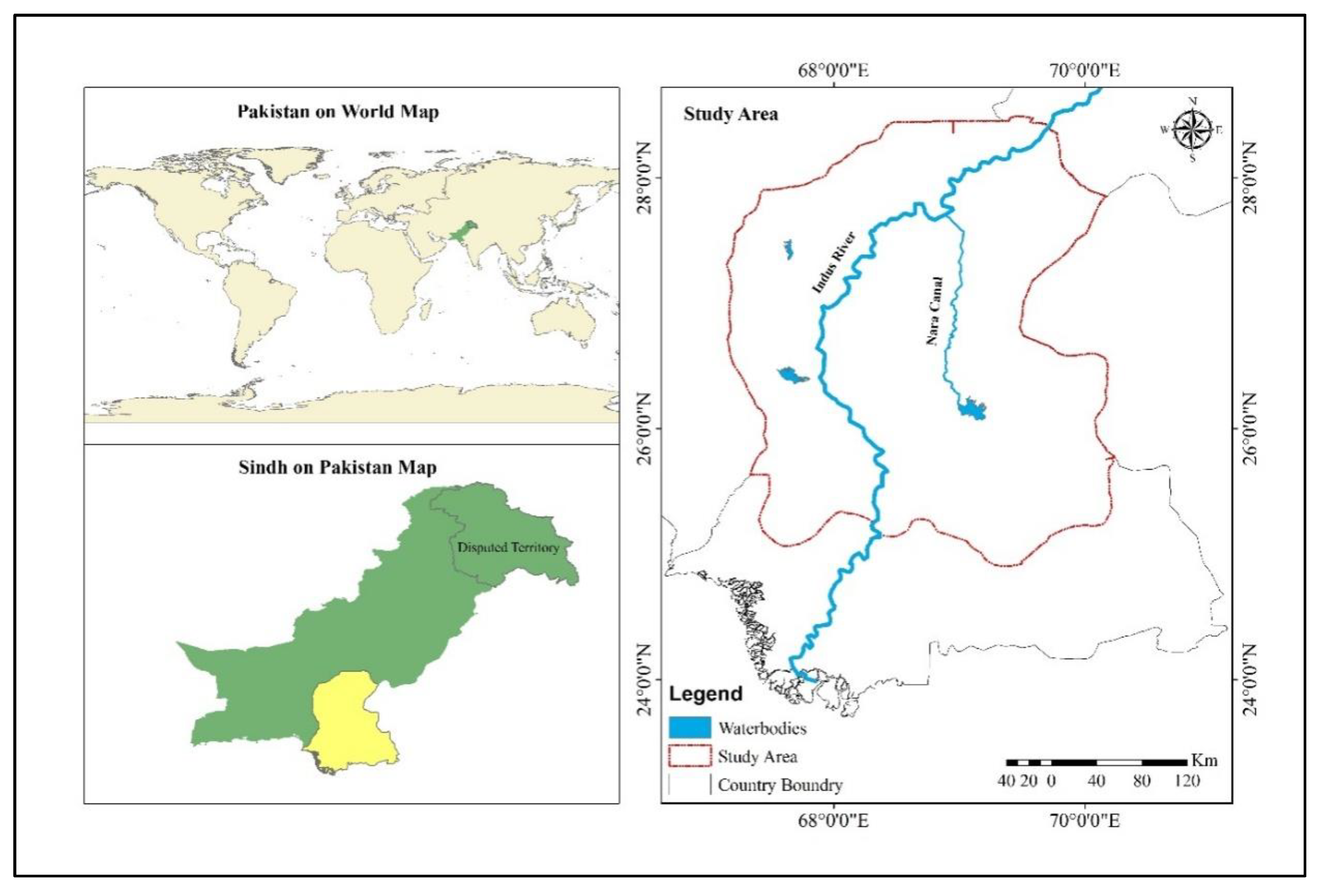
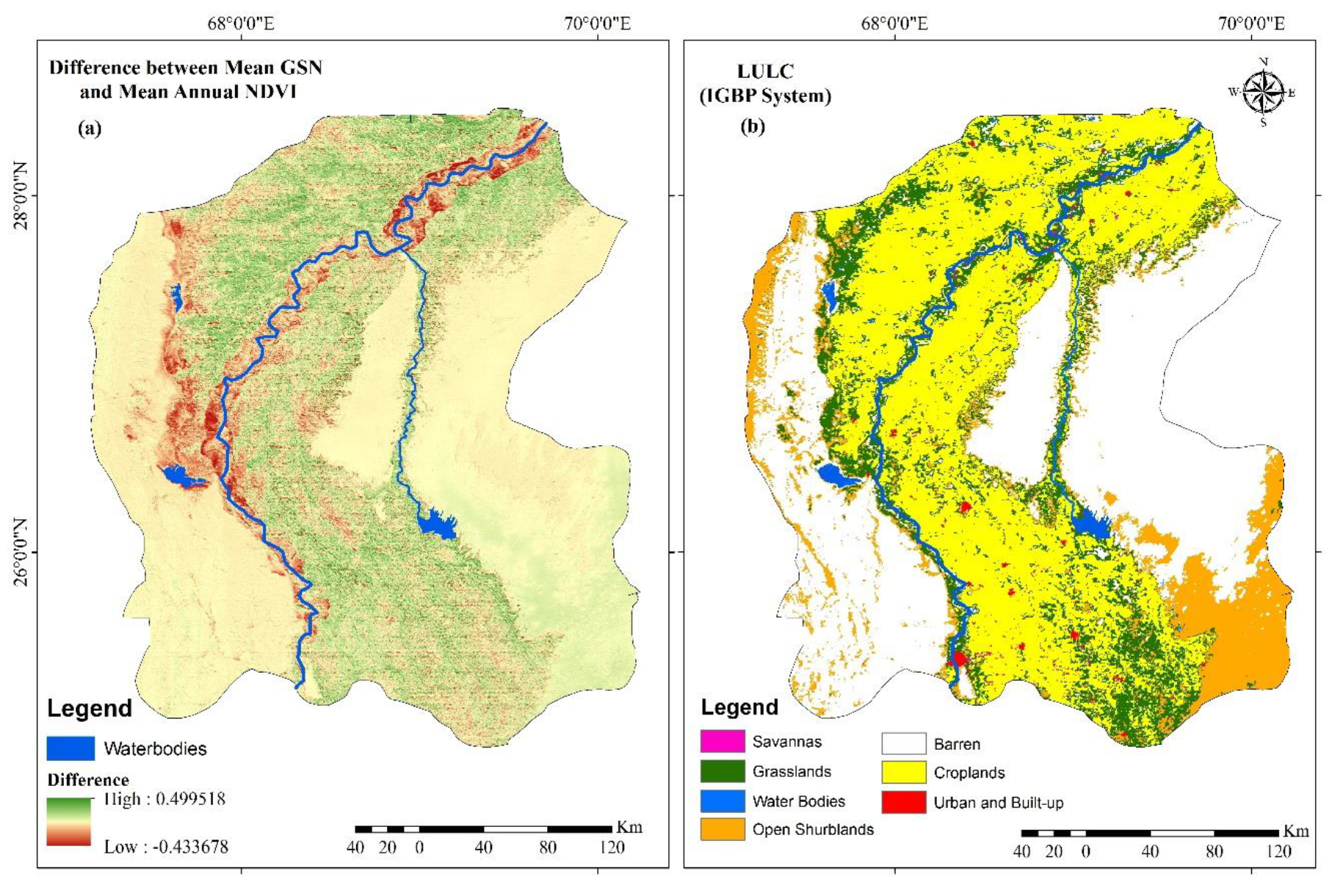
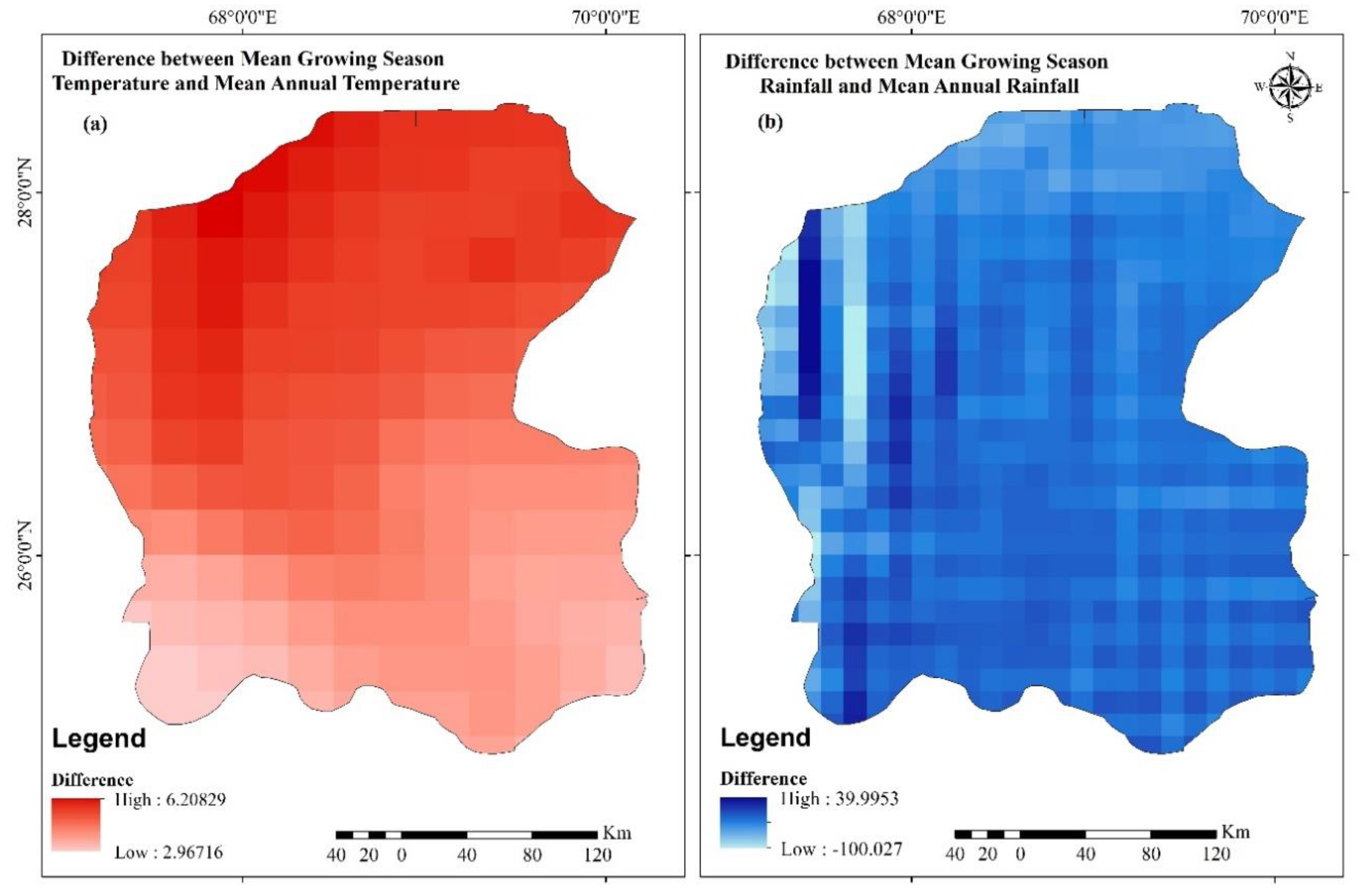
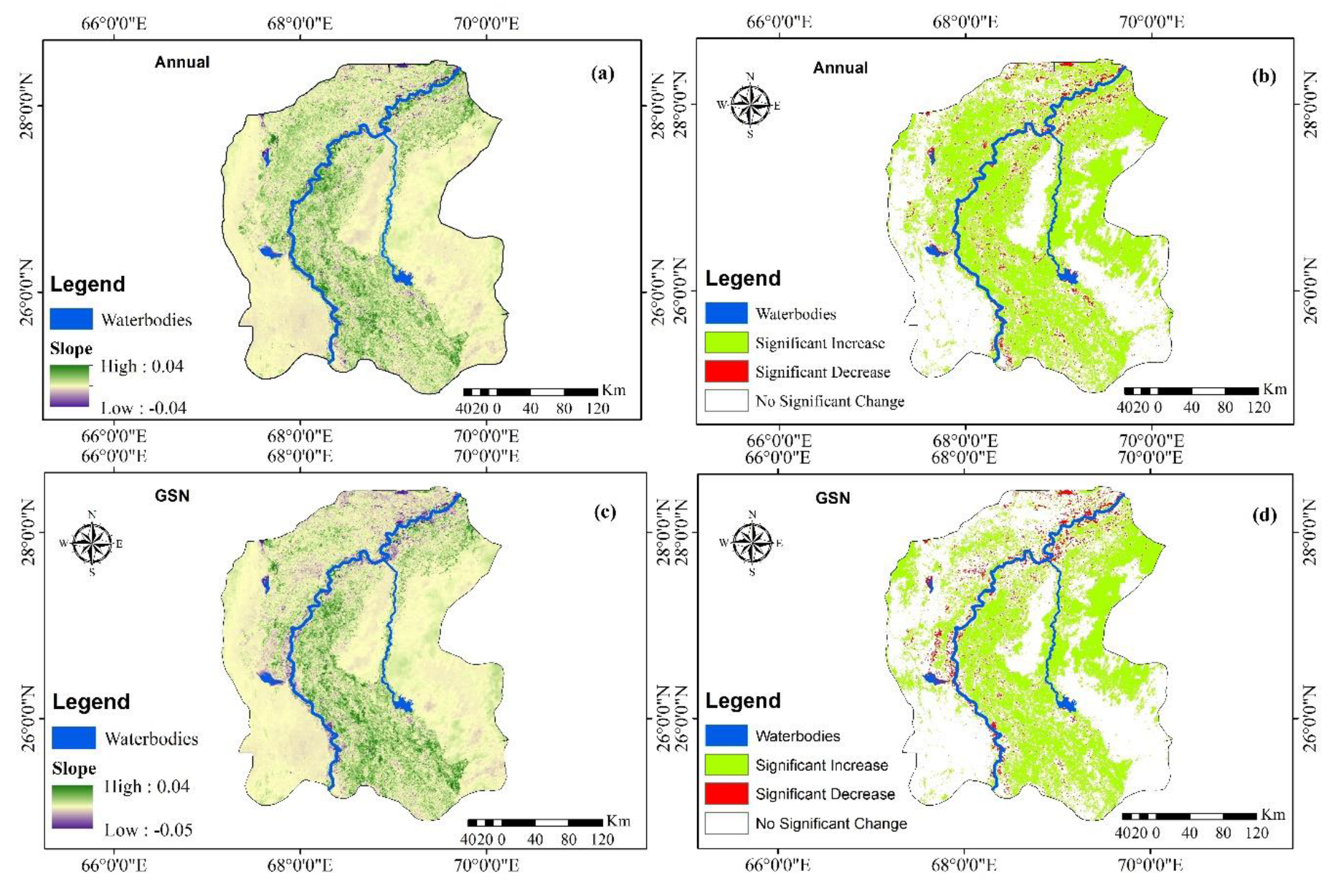
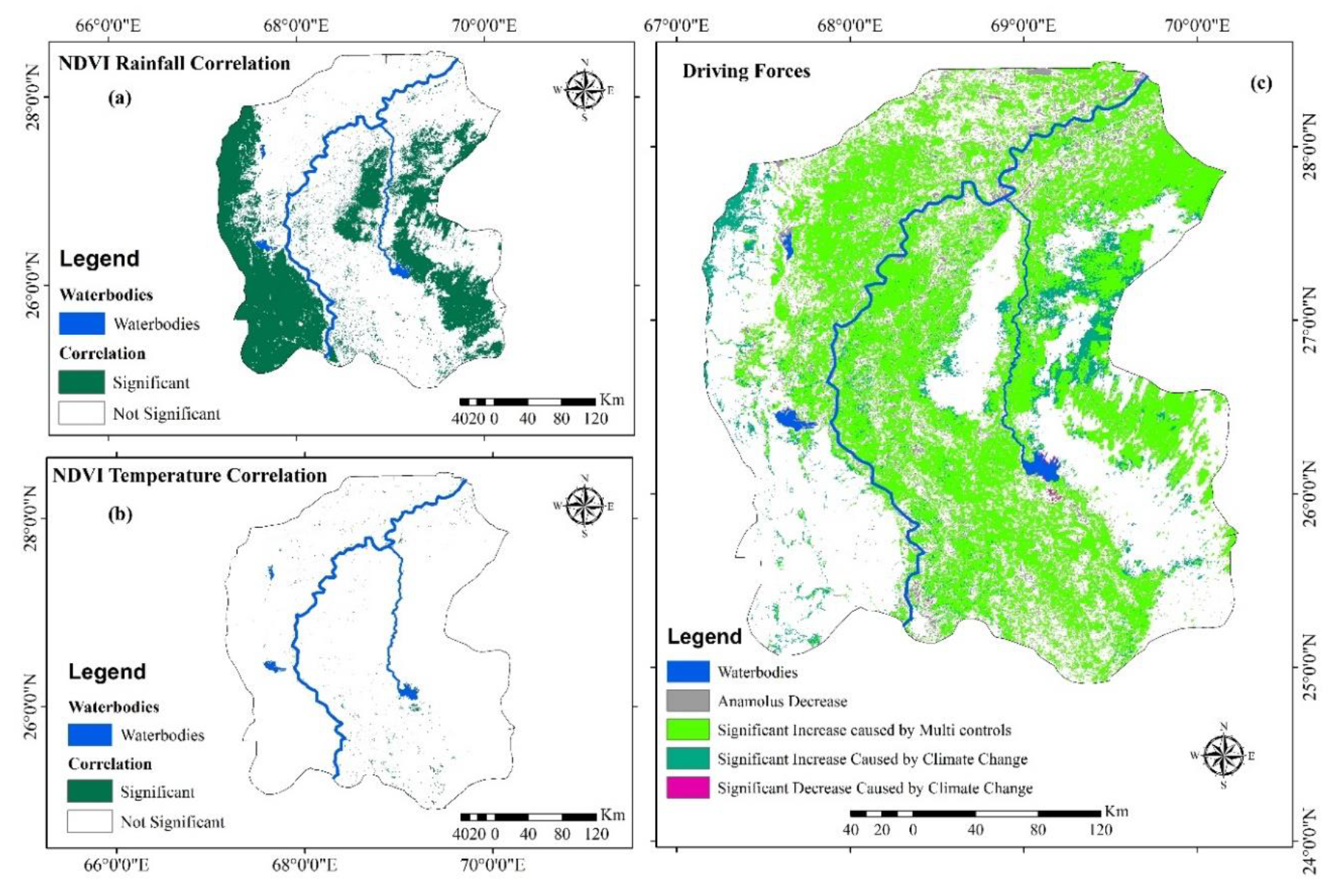
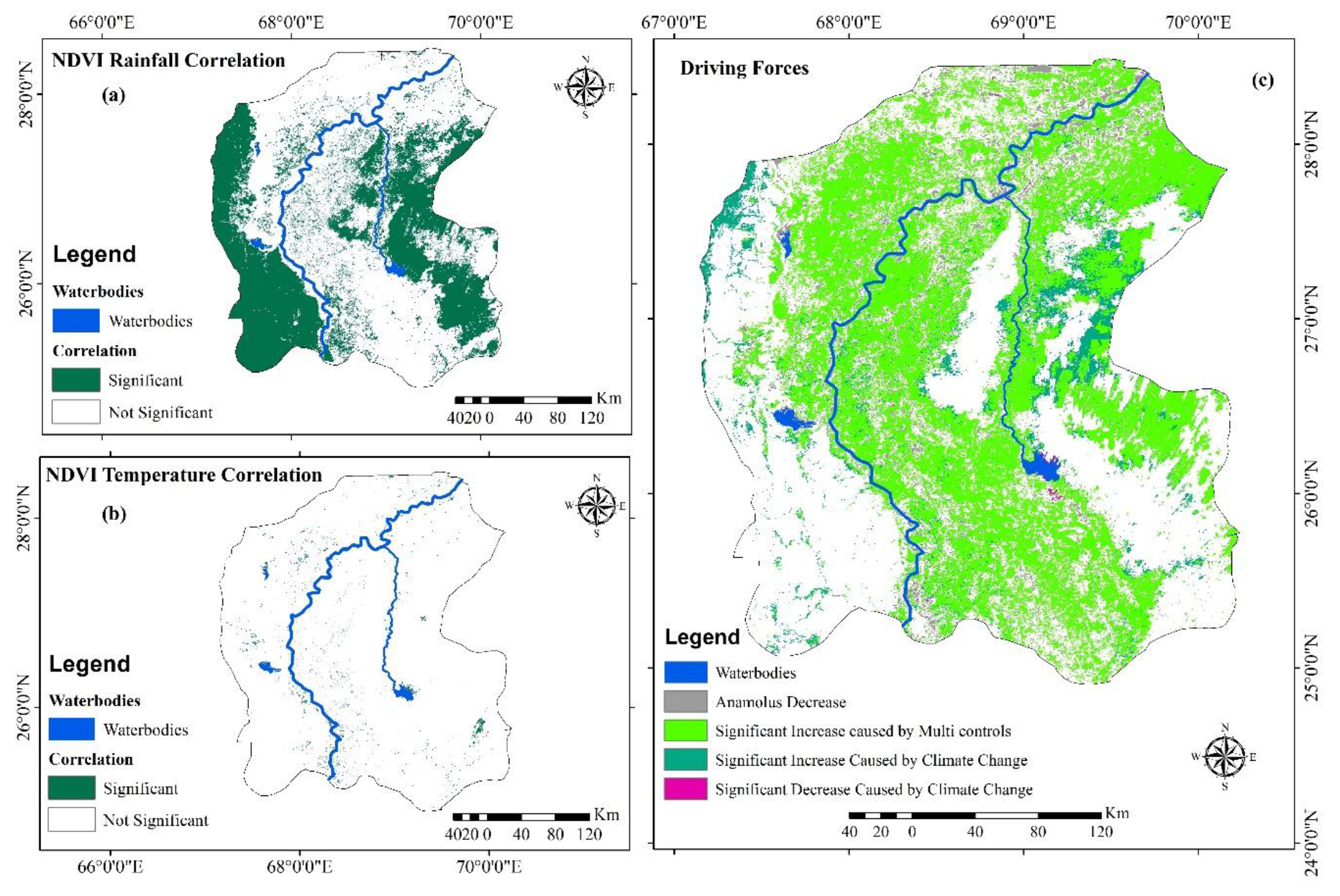
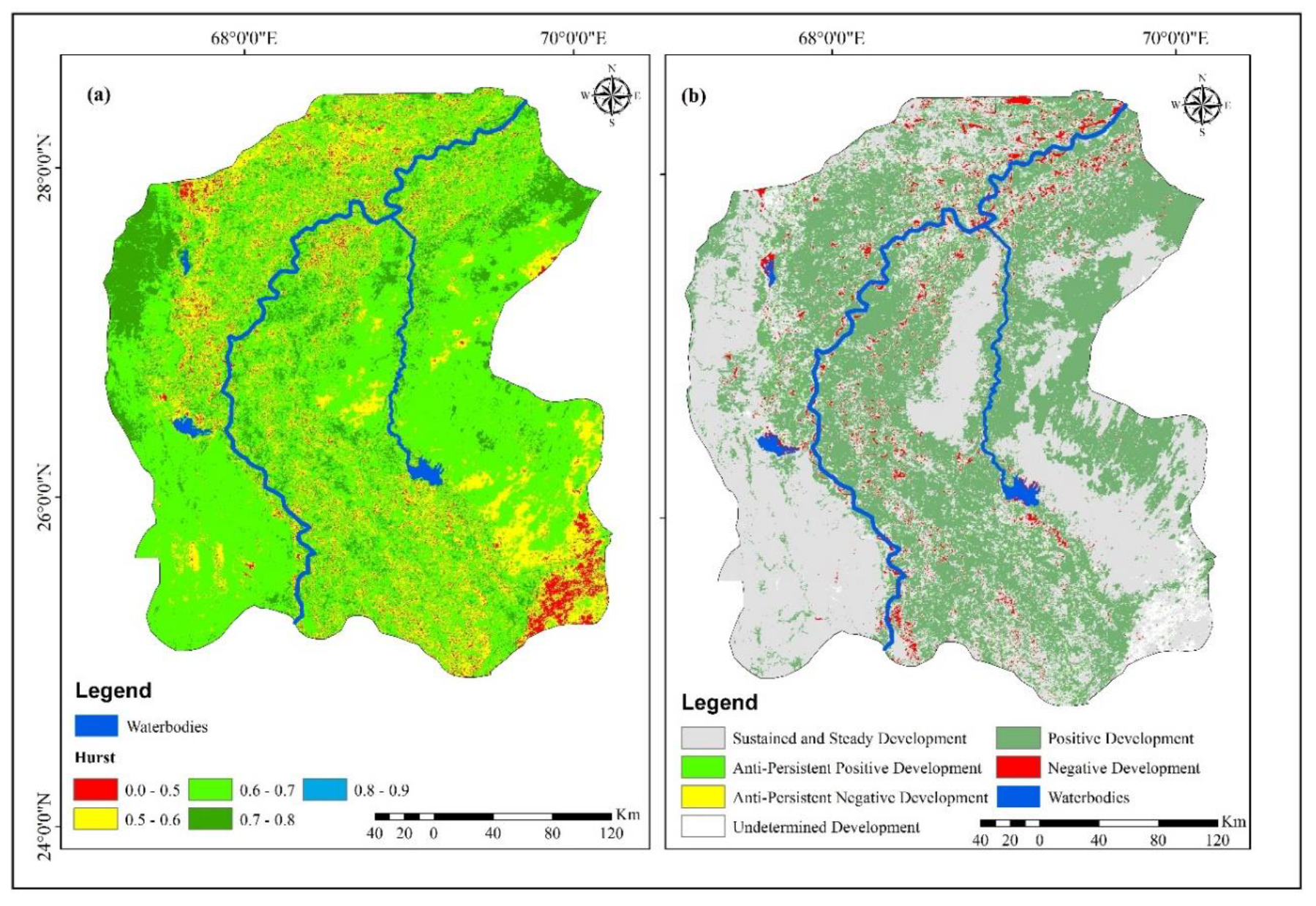
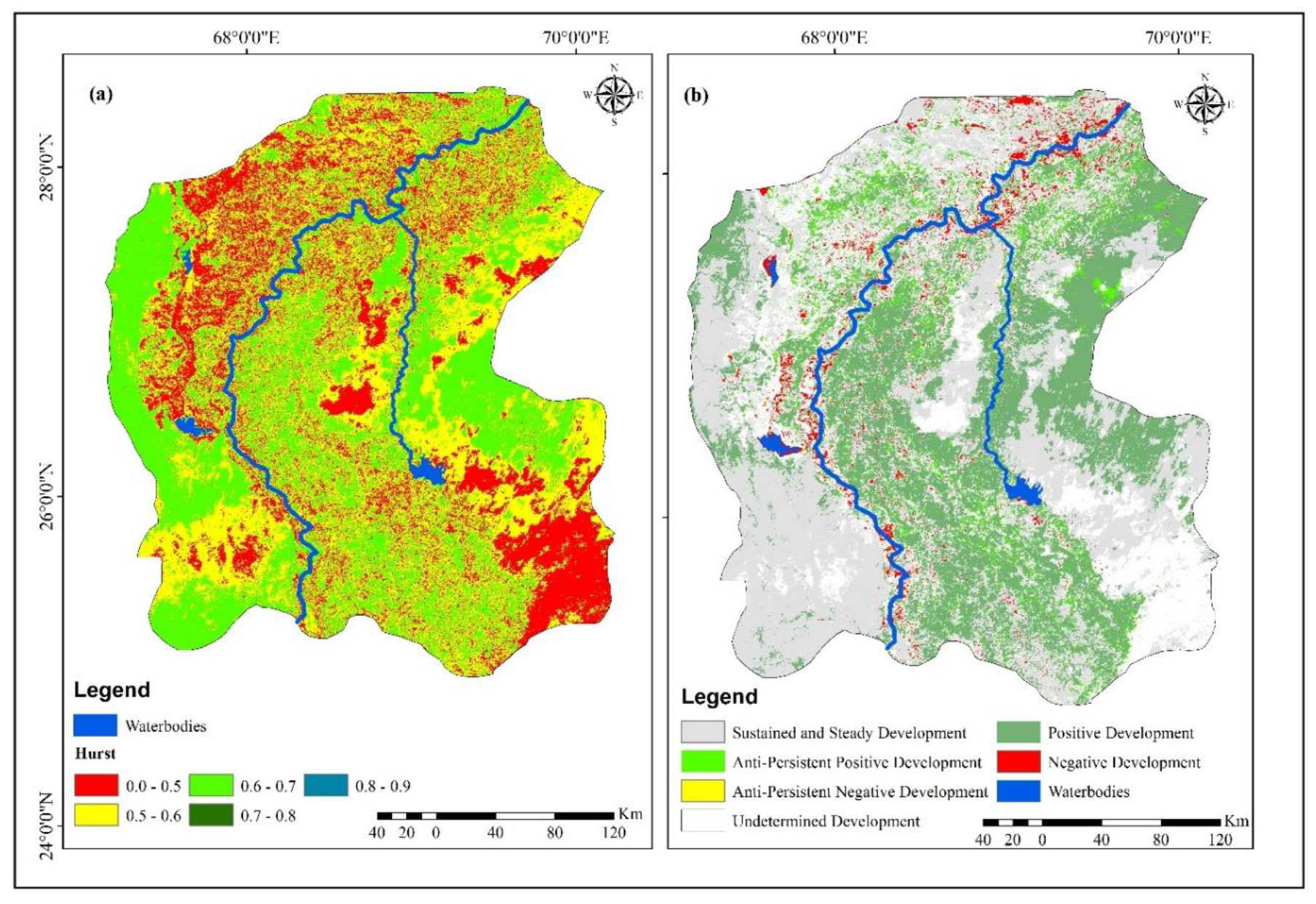
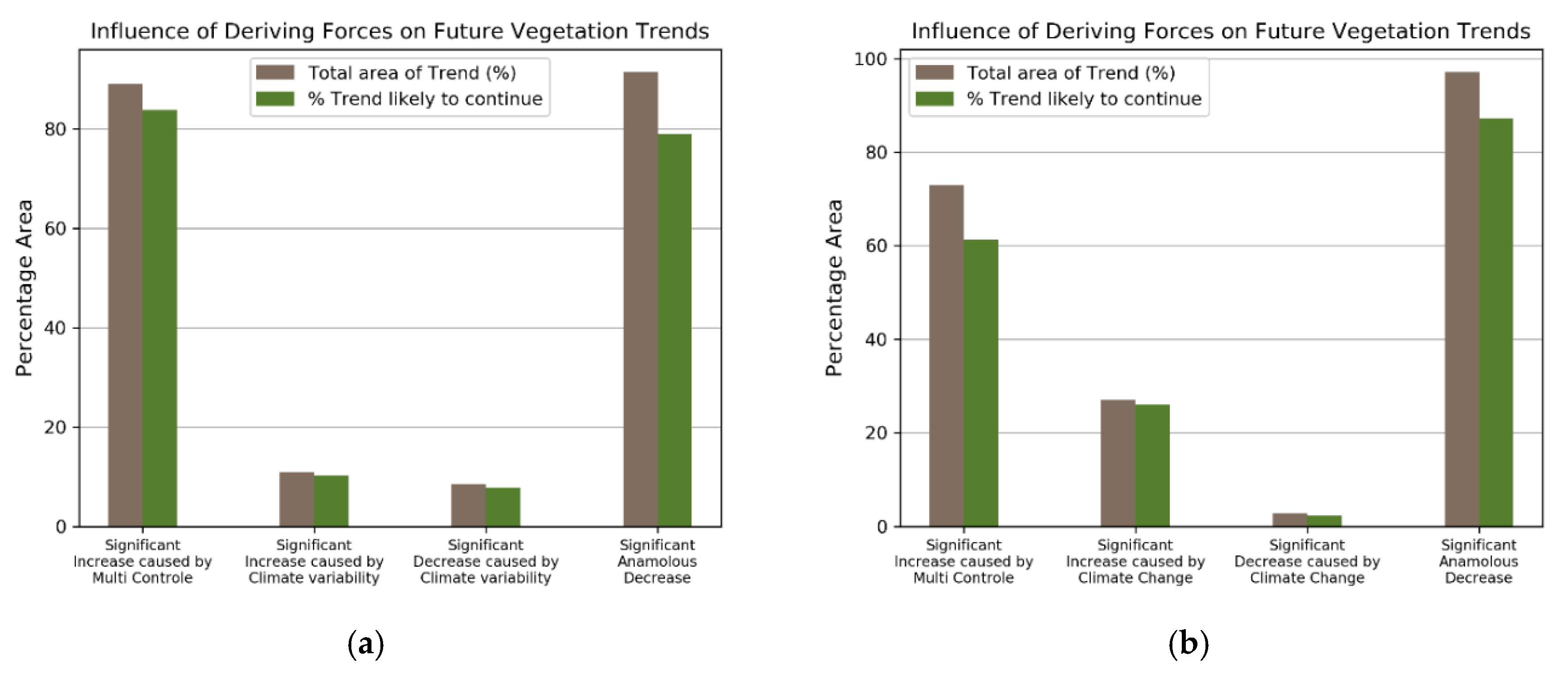

| Sr. | Trend | H-Value | Description |
|---|---|---|---|
| 1 | Positive trend | >0.5 | Positive Development |
| 2 | Positive trend | <0.5 | Anti-persistent positive development |
| 3 | Negative Trend | >0.5 | Negative Development |
| 4 | Negative Trend | <0.5 | Anti-persistent negative development |
| 5 | No Significant Trend | >0.5 | Stable and steady development |
| 6 | No Significant Trend | <0.5 | Undetermined development |
© 2020 by the authors. Licensee MDPI, Basel, Switzerland. This article is an open access article distributed under the terms and conditions of the Creative Commons Attribution (CC BY) license (http://creativecommons.org/licenses/by/4.0/).
Share and Cite
Bashir, B.; Cao, C.; Naeem, S.; Zamani Joharestani, M.; Bo, X.; Afzal, H.; Jamal, K.; Mumtaz, F. Spatio-Temporal Vegetation Dynamic and Persistence under Climatic and Anthropogenic Factors. Remote Sens. 2020, 12, 2612. https://doi.org/10.3390/rs12162612
Bashir B, Cao C, Naeem S, Zamani Joharestani M, Bo X, Afzal H, Jamal K, Mumtaz F. Spatio-Temporal Vegetation Dynamic and Persistence under Climatic and Anthropogenic Factors. Remote Sensing. 2020; 12(16):2612. https://doi.org/10.3390/rs12162612
Chicago/Turabian StyleBashir, Barjeece, Chunxiang Cao, Shahid Naeem, Mehdi Zamani Joharestani, Xie Bo, Huma Afzal, Kashif Jamal, and Faisal Mumtaz. 2020. "Spatio-Temporal Vegetation Dynamic and Persistence under Climatic and Anthropogenic Factors" Remote Sensing 12, no. 16: 2612. https://doi.org/10.3390/rs12162612
APA StyleBashir, B., Cao, C., Naeem, S., Zamani Joharestani, M., Bo, X., Afzal, H., Jamal, K., & Mumtaz, F. (2020). Spatio-Temporal Vegetation Dynamic and Persistence under Climatic and Anthropogenic Factors. Remote Sensing, 12(16), 2612. https://doi.org/10.3390/rs12162612






